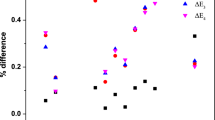Abstract
The methods that have been used in the past to derive the electron repulsion parameters,B andC, from the spectra of octahedral Cr(III) complexes have been reinvestigated. A number of Cr(III) complexes were chosen for which the spin-forbidden transitions to the three lowest doublet states are known. The complete strong field and weak field matrices have been used to derive the parametersB andC from the known spectral data. A convenient graphical method is given which makes it a simple matter to choose the “best” values ofB andC. The assumption that C=4B was discarded because it is incompatible with the nephelauxetic effect.
The three parameter (Δ, B, C) crystal field theory reproduces the band positions of thed-d transitions of most Cr(III) complexes to within a few hundred wavenumbers. Because the free ion theory of Condon and Shortley involves about the same uncertainty, it is felt that the results obtained here represent the best that can be obtained from the three parameter crystal field theory.
Zusammenfassung
Einige Methoden, die bislang benutzt wurden, um die ElektronenabstoßungsparameterB und C aus den Spektren der oktaedrischen Cr(III)-Komplexe zu berechnen, wurden nochmals untersucht, und zwar wurden solche Cr(III)-Komplexe ausgewählt, für die die spinverbotenen Übergänge in die drei untersten Doublet-Zustände bekannt sind. Mittels der vollständingen Matrizen für starkes und schwaches Feld wurden dann die ParameterB undC aus den vorliegenden spektralen Daten berechnet, und eine brauchbare graphische Methode wird angegeben, die das Auffinden der „besten” Werte vonB undC einfach macht. Die Annahme C=4B wurde verworfen, weil sie mit dem nephelauxetischen Effekt unvereinbar ist.
Die drei-parametrige (Δ, B, C)-Kristallfeldtheorie gibt die Lagen der Banden derd-d Übergänge bei den meisten Cr(III)-Komplexen bis auf einige hundert Wellenzahlen richtig wieder. Weil die Theorie der freien Ionen von Condon und Shortley etwa gleich große Fehler impliziert, kann man annehmen, daß die hier erzielten Resultate das Beste darstellen, was von einer drei-parametrigen Kristallfeldtheorie zu erhalten ist.
Résumé
On a réétudié les méthodes utilisées dans le passé pour obtenir les paramètres de répulsion électronique,B etC, à partir des spectres des complexes octaédriques de Cr (III). Le choix s'est porté sur un certain nombre de complexes de Cr(III) pour lesquels les transitions interdites par le spin vers les trois plus bas états doublets sont connues. Les matrices complètes à champ fort et à champ faible ont été utilisées pour obtenir les paramètresB etC à partir des données spectrales connues. Une méthode graphique convenable permet de choisir simplement les meilleures valeurs deB etC. L'hypothèse selon laquelle C=4B a été rejetée parcequ'elle est incompatible avec l'effet nephelauxetique.
La théorie du champ cristallin à trois paramètres (Δ, B, C) reproduit les positions des bandes des transitionsd — d de la plupart des complexes de Cr (III) à moins de quelques centaines de nombre d'onde près. La théorie de l'ion libre de Condon et Shortley comportant la même incertitude, il semble que les résultats obtenus ici représentent ce que l'on peut obtenir de mieux dans la théorie du champ cristallin à trois paramètres.
Similar content being viewed by others
References
Bethe, H.: Ann. Physik3, 133 (1929).
Penney, W. G., Schlapp, R.: Physic. Rev.41, 194 (1932);42, 666 (1932).
Van Vleck, J. H.: Physic. Rev.41, 208 (1932).
McClure, D. S.: Solid State Physics9, 399 (1959).
Griffith, J. S.: The Theory of Transition Metal Ions, Cambridge 1961.
Ballhausen, C. J.: Introduction to Ligand Field Theory, McGraw Hill 1962.
-Gray, H. B.: Molecular Orbital Theory, chapter 8, Benjamin 1965.
Shulman, R. G., Sugano, S.: J. chem. Physics42, 39 (1965).
Alexander, J. J., Gray, H. B.: J. Amer. chem. Soc.90, 4260 (1968).
Cotton, F. A., Haas, T. E.: Inorg. Chem.3, 1004 (1964).
Koide, S., Pryce, M. H. L.: Philos. Mag.3, 607 (1958).
Finkelstein, R., Van Vleck, J. H.: J. chem. Physics8, 790 (1940).
Orgel, L. E.: J. chem. Physics23, 1004, 1819, 1824 (1955).
Tanabe, Y., Sugano, S.: J. Physic. Soc. Japan 9,753, 766 (1954).
Wood, D. L., Ferguson, J., Knox, K., Dillon, J. F., Jr.: J. chem. Physics39, 890 (1963).
Jorgensen, C. K.: Acta chem. scand.12, 903 (1958).
-Absorption Spectra and Chemical Bonding in Complexes, Pergamon Press 1962.
—: Advances chem. Physics8, 47 (1965).
—: Progr. Inorg. Chem.4, 73 (1962).
—: Advances chem. Physics5, 33 (1963).
—: Discuss. Faraday Soc.26, 110 (1958).
—: Solid State Physics13, 375 (1962).
Trees, R. E., Jorgensen, C. K.: Physic. Rev.123, 1278 (1961), and references contained therein.
Pryce, M. H. L., Agnetta, G., Garofano, T., Palma-Vittorelli, M. B., Palma, M. U.: Philos. Mag.10, 477 (1964).
Ferguson, J., Wood, D. L.: Austral. J. Chem.23, 861 (1970).
Liehr, A. D.: J. physic. Chem.67, 1314 (1963).
Forster, L. S.: In Transition Metal Chemistry, vol. V, Chapter 1, ed. by Carlin, R. L., Marcel Dekker 1969.
Schläfer, H. L., Gausmann, H., Zander, H. U.: Inorg. Chem.6, 1528 (1967).
Kushida, T.: J. Physic. Soc. Japan21, 1331 (1966).
Dingle, R.: J. chem. Physics50, 1952 (1969).
Porter, G. B.: Private communication.
Unpublished data of the author.
Condrate, R., Forster, L. S.: J. Molecular Spectroscopy24, 490 (1967).
Mortensen, O. S.: J. Chem. Physics47, 4215 (1967).
Witzke, H.: Ph. D. Thesis, University of British Columbia, 1970.
Dunken, H., Marx, G.: Z. Chem.6, 436 (1966).
Dillon, J. F., Jr., Kamimura, H., Remeika, J. P.: J. Appl. Physics34, 1240 (1963).
Pfeil, A.: Diplomarbeit, Frankfurt am Main, 1966.
Tsuchida, R.: Bull. chem. Soc. Japan13, 388, 436, 471 (1938).
Condon, E. U., Shortley, G. H.: The Theory of Atomic Spectra, Cambridge, 1963.
de Armond, K., Forster, L. S.: Spectrochimica Acta19, 1403 (1963).
Stanton, R. G.: Numerical Methods for Science and Engineering, p. 98. Prentice Hall 1961.
Griffith, J. S., Orgel, L. E.: Quart. Rev.11, 381 (1957).
Racah, G.: Physic. Rev.62, 438 (1942).
Jorgensen, C. K.: Acta chem. scand.9, 887, 1362 (1955).
Author information
Authors and Affiliations
Additional information
Dedicated to the memory of Professor Hans-Ludwig Schläfer.
Rights and permissions
About this article
Cite this article
Witzke, H. Semi-empirical evaluations of the racahB andC parameters from the crystal field spectra of chromium(III) complexes. Theoret. Chim. Acta 20, 171–185 (1971). https://doi.org/10.1007/BF00569263
Received:
Issue Date:
DOI: https://doi.org/10.1007/BF00569263




